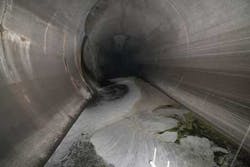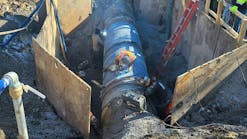| Workers are lowered by crane down into the Deep Tunnel as part of Milwaukee Metropolitan Sewerage District's (MMSD) Deep Tunnel Maintenance Project. Photo by Chris Duzynski, courtesy of Veolia Water North America. |
MMSD partnered with Veolia Water North America in March 2008 to operate and maintain the Deep Tunnel, as well as two wastewater treatment facilities, the conveyance system, and the Milorganite production facility.
Cleaning a 'Giant Pipe'
The numbers speak for themselves. Before the Deep Tunnel went into operation, there were 50 to 60 combined sewer overflows annually. Since 1994, the average has declined to 2.5 overflows per year. But like every piece of equipment in a wastewater system, the Deep Tunnel needs to be maintained at regular intervals in order to ensure it operates properly.
As part of Veolia Water's contract with MMSD, once every 10 years, the Deep Tunnel must be cleaned of floatable debris that eludes capture by periodic efforts from above ground.
Because of the unique safety and logistical challenges of this subterranean asset management effort, specially trained crews from Veolia prepared months in advance for this effort, bringing in confined space and water treatment experts to ensure the crews were prepared for the conditions they'd experience working underground. Working 300 feet below the surface, Veolia crews were routinely hundreds of feet from an access shaft, working in what would otherwise be complete darkness. They had to be prepared to evacuate at a moment's notice in the event of rapidly developing storms.
Having determined that a system that relied on flotation to move material through the tunnel would be the most effective, Veolia set to work designing and building a boat and conveyor system that could be lowered into the tunnel via a crane through the access shaft. In addition, specially built baskets were constructed that could handle the extreme weight loads of water-soaked material being lifted up from the tunnel.








